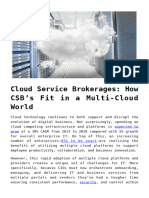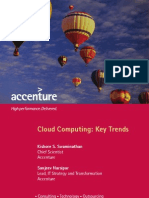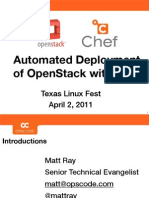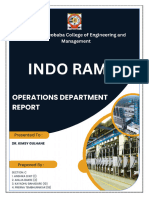210 Opinion
210 Opinion
Uploaded by
Nadia MetouiCopyright:
Available Formats
210 Opinion
210 Opinion
Uploaded by
Nadia MetouiCopyright
Available Formats
Share this document
Did you find this document useful?
Is this content inappropriate?
Copyright:
Available Formats
210 Opinion
210 Opinion
Uploaded by
Nadia MetouiCopyright:
Available Formats
Send your contribution to the editor-in-chief at mats.thoren@jgcommunication.
se
oPinion
aMy DeCarlo
Dont enter the cloud alone
is there room in the cloud for operators or will integrators dominate? The answer comes down to how successful carriers are in both capitalizing on the strengths of their own infrastructure and in putting together productive partner alliances.
Just the mention of cloud computing can spur passionate provisioning, and allows customers to access cloud content from any debate over everything from how to define it to whether the device model will move the IT industry forward or set it back. Yet even as arguResource pooling: multi-tenant architecture improves efficiency and ments rage about whether cloud computing is a major advance or an reduces costs inherently insecure delivery model, uncertain economic times are driving Rapid elasticity: IT services can be deployed quickly and customers pay businesses attracted by the promise of radical cost only for what they use reductions to take a serious look at where it could fit in Measured service: resource utilization is optimized ...operators are at a their organization. automatically The attraction is obvious. After all, what business NIST also defines three general service models: disadvantage with wouldnt want a lowercost, more flexible IT service Infrastructure as a Service (IaaS): The customer can respect to higher level alternative to conventional hosted or insourcing models provision processing, storage, networks and other basic services or cloud that still allows a level of control over deployment? computing resources. The customer does not have any IT professionals are therefore looking at handing over direct control over the underlying cloud environment computing deployments the keys to the kingdom to a third party. But displacebut can administer operating systems, storage, or other that rise above the ment isnt the only concern; IT administrators grapple resources where the customer is able to deploy and foundational IaaS layer with questions about security, transparency, complirun arbitrary software, which can include operating or involve the connection ance, stability and performance. However, serious long systems and applications. term IT budget constraints are forcing even the most Platform as a Service (PaaS): The provider supplies the of multiple clouds. reticent into the on-demand sector. end customers with a hosted environment from which The near-universal appeal of lower-cost technology they can access applications created by the provider services at a time of deep financial cuts is expected to only fuel market and third parties using tools supplied by the provider. growth. Merrill Lynch estimates cloud computing services will generate Software as a Service (SaaS): Clients access application software via USD 95 billion in revenues by 2011. any number of devices through an interface such as a web browser. In This demand for operational expenditure-based services represents the NIST definition, cloud services can be delivered using one of four a tantalizing opportunity for IT providers that are able to deliver highdeployment models: performing managed solutions. However, trepidation about the stability Private Cloud: the cloud infrastructure supports a single customer and security of the cloud puts intense pressure on providers to deliver Public Cloud: multiple customers share the same environment on the promise of the model. Community Cloud: multiple organizations with a common interest share the same cloud infrastructure characterizing the cloud Hybrid Cloud: the cloud infrastructure consists of multiple connected So what does this model involve? There are probably nearly as many clouds that share resources (more about cloud definitions, see definitions of cloud computing today as there are companies selling page 56) products and services in this space. However, the US National Institute of Standards and Technology (NIST) has produced a comprehensive list the lay of the land of the elements involved. These include: Drawn by the promising growth potential, any number of companies On-demand self-service: automation limits human intervention around are jockeying for position in the cloud from conventional software
58 EBR #2 2010
companies to traditional hosting providers. For telecom operators facing declining profit margins for voice services, there is a particular urgency about moving to on-demand service delivery. This pressure is increasing as customers push them to deliver core services using a model that allows for more self-service provisioning and pay-for-use options. However, telecom operators face a myriad of challenges as they look to make their presence known in the cloud, not least that many customers think of them as suppliers of commodity communications services, not solutions that are tightly integrated with key corporate applications. This is unfortunate because operators are particularly well-suited to play a role in the cloud that effectively leverages their network and data center assets, along with the reach these resources give them. Operators also often have an installed base of customers who might be inclined to invest in solutions, such as utility computing, delivered through the cloud. However, operators are at a disadvantage with respect to higherlevel services or cloud computing deployments that rise above the foundational IaaS layer or involve the connection of multiple clouds. Most telecom operators, even those with substantial application hosting skill sets, lack market credibility when it comes to the most ambitious and potentially lucrative cloud services agendas. And it is these that generate the large-scale engagements covering strategic business areas. Enterprise customers are more likely to seek out IT providers with application development and integration expertise, and vertical industry knowledge for help with strategic cloud initiatives. power in numbers This is where partnerships come into play but not superficial marketing relationships. Operators need close collaborations with IT solution providers that marry the application development and integration expertise, and vertical skill set of a traditional integrator with their own scale and networking skill set. Investing in these kinds of alliances can help
amy laRsen decaRlo works as Principal analyst, security and Data Center services at market intelligence firm Current analysis. she applies 17 years experience in covering the It industry to assess the managed It services sector with a particular emphasis on security and data center solutions delivered through the cloud including on demand application, unified communications and collaboration, and managed storage offerings. she can be reached at adecarlo@currentanalysis.com
telecom operators engage better with the market by developing and deploying cloud services quickly. In these relationships, the telecom operator may maintain a lower profile while the integrator partner has the primary role in building the business case for the cloud and helping deploy it. Telecom operators do provide more than simply a set of data center facilities and a pipe to the end user. Operators give customers access to a highly efficient virtual environment through a portal, supplying resources that run the gamut from firewalls and load balancers to the servers themselves. Partners can create particular use cases such as dynamic network provisioning that allow customers to quickly set up and then tear down a cloud environment that can be used to support effective project collaboration or initiatives built around the customers specific corporate objectives. While integrator partners can help a telecom operator establish its credibility in the space, the operator can differentiate itself from rivals on the basis of the flexibility and stability of its service delivery and the breadth of its ISV partner ecosystem. Operators can take a page from the books of Microsoft and Google, which are building up significant networks of software and hardware suppliers, and create a much more high-functioning environment that provides customers (or even partners) with the tools and applications they need for particular tasks. The cloud, after all, is vast. No one company can successfully go it alone in this space.
EBR #2 2010 59
You might also like
- Apply Size Premium MetricsDocument4 pagesApply Size Premium MetricsmarianoveNo ratings yet
- BT Lifter - LHM230Document26 pagesBT Lifter - LHM230Efrain AvilaNo ratings yet
- Business Implementation of Cloud ComputingDocument6 pagesBusiness Implementation of Cloud ComputingQuaid Johar SodawalaNo ratings yet
- A Study of Cloud Computing MethodologyDocument5 pagesA Study of Cloud Computing MethodologyR Dharshini SreeNo ratings yet
- NSN Telco Cloud White Paper 1Document15 pagesNSN Telco Cloud White Paper 1AbderrazekHmidetNo ratings yet
- Tata Communications CloudCompuing Whitepaper v2Document24 pagesTata Communications CloudCompuing Whitepaper v2Nana KiruiNo ratings yet
- Cloud Computing - A Primer For Outsource LawyersDocument5 pagesCloud Computing - A Primer For Outsource Lawyersgaby31juanNo ratings yet
- Welingkar Institute of Management Development & Research: Ankit PatilDocument29 pagesWelingkar Institute of Management Development & Research: Ankit PatilAditya DixitNo ratings yet
- 1.1 Cloud Computing - IntroductionDocument19 pages1.1 Cloud Computing - IntroductionAkn NanthanNo ratings yet
- Data Center Cloud WPDocument12 pagesData Center Cloud WPaajayhsharmaNo ratings yet
- The Role of Security in Trustworthy Cloud ComputingDocument12 pagesThe Role of Security in Trustworthy Cloud ComputingHarish RawatNo ratings yet
- Technology: by Ross TisnovskyDocument3 pagesTechnology: by Ross TisnovskyPhattharabophit Pat NanongkhaNo ratings yet
- The Open Cloud Manifesto: A Call To Action For The Worldwide Cloud CommunityDocument6 pagesThe Open Cloud Manifesto: A Call To Action For The Worldwide Cloud CommunityPrasad SpNo ratings yet
- Cloud Computing For Financial Institutions: Vivek KejriwalDocument9 pagesCloud Computing For Financial Institutions: Vivek KejriwalPriyanka DhawanNo ratings yet
- Interim Report v2Document11 pagesInterim Report v2Peeyush ThakurNo ratings yet
- Demystifying The CloudDocument8 pagesDemystifying The CloudiambmNo ratings yet
- Idc Executive Brief: Cloud Computing in The Midmarket: Assessing The OptionsDocument7 pagesIdc Executive Brief: Cloud Computing in The Midmarket: Assessing The OptionsBiodor BonifacioNo ratings yet
- Cloud Computing OverviewDocument25 pagesCloud Computing OverviewAli GHORBELNo ratings yet
- Security and Privacy (Final)Document7 pagesSecurity and Privacy (Final)Abin Varkey VargheseNo ratings yet
- Force10 Networks: Rising To The Challenges of Cloud Computing NetworksDocument6 pagesForce10 Networks: Rising To The Challenges of Cloud Computing NetworksalpvistaNo ratings yet
- Cloud ComputingDocument5 pagesCloud ComputingkevmatinNo ratings yet
- Q1Q2Q3Q4Q5Document35 pagesQ1Q2Q3Q4Q5Ramesh JiNo ratings yet
- Cloud Service Brokerages HowCSB's Fit in A Multi-CloudWorldDocument7 pagesCloud Service Brokerages HowCSB's Fit in A Multi-CloudWorldguhanram24No ratings yet
- Thesis On Cloud ComputingDocument71 pagesThesis On Cloud Computingashutoshsnp96No ratings yet
- Enterprise Information Systems and Strategic Management: ContentDocument5 pagesEnterprise Information Systems and Strategic Management: ContentReseen SyedNo ratings yet
- Will Cloud Rain On Resellers' Parade?Document3 pagesWill Cloud Rain On Resellers' Parade?quocircaNo ratings yet
- Improving Business Performance Through New IT Service Delivery ModelsDocument2 pagesImproving Business Performance Through New IT Service Delivery Modelsprofound2meNo ratings yet
- Five Key Factors To Prepare 375399Document11 pagesFive Key Factors To Prepare 375399Gustavo CarvalhoNo ratings yet
- Cloud Computing Correctd VersionDocument9 pagesCloud Computing Correctd VersionHafsa JehangirNo ratings yet
- Task 1 Cloud ComputingDocument7 pagesTask 1 Cloud ComputinghasanhayatNo ratings yet
- IBM CloudDocument11 pagesIBM CloudYadi RachmanNo ratings yet
- Network As A ServiceDocument14 pagesNetwork As A ServiceHarish VadadaNo ratings yet
- Cloud Computing Key TrendsDocument5 pagesCloud Computing Key TrendsVinod JoshiNo ratings yet
- Cloud Computing: Challenges and Proposed Techniques To Address ProblemsDocument15 pagesCloud Computing: Challenges and Proposed Techniques To Address ProblemsUnduh BahanNo ratings yet
- 11 F Pankaj AroraDocument6 pages11 F Pankaj AroraragvshahNo ratings yet
- Loud Computing: Download Now: Speech-to-Text Services: AWS vs. Microsoft vs. GoogleDocument26 pagesLoud Computing: Download Now: Speech-to-Text Services: AWS vs. Microsoft vs. GoogleVincent MoralesNo ratings yet
- Cloud Clarity The Key Tpo SuccessDocument3 pagesCloud Clarity The Key Tpo SuccessquocircaNo ratings yet
- SurveyonCloudComputingwithCloudService Model PDFDocument5 pagesSurveyonCloudComputingwithCloudService Model PDFInternational Journal of Advanced and Innovative ResearchNo ratings yet
- Security and Privacy Challenges in Cloud Computing EnvironmentsDocument8 pagesSecurity and Privacy Challenges in Cloud Computing EnvironmentsNaveed IrshadNo ratings yet
- Cloud Computing Software ContractsDocument16 pagesCloud Computing Software ContractsJohn Eric RichardsNo ratings yet
- Unit 3 CCDocument42 pagesUnit 3 CCkaveripadmabaswaNo ratings yet
- Cloud Computing in Large Enterprises - Questions For The C-SuiteDocument5 pagesCloud Computing in Large Enterprises - Questions For The C-SuiteAparna Nayyar GoelNo ratings yet
- Cloud Computing Overview - Torry Harris WhitepaperDocument6 pagesCloud Computing Overview - Torry Harris WhitepaperTorry Harris Business SolutionsNo ratings yet
- X433 Data Comm Final ProjectDocument6 pagesX433 Data Comm Final ProjectJackie MicianoNo ratings yet
- Osamah Shihab Al-NuaimiDocument7 pagesOsamah Shihab Al-NuaimiOmar AbooshNo ratings yet
- Future of Mobile NetworksDocument24 pagesFuture of Mobile NetworksavaldirisNo ratings yet
- Cloud ComputingDocument10 pagesCloud ComputingTameta DadaNo ratings yet
- Cloud Computing V1Document10 pagesCloud Computing V1balu mishraNo ratings yet
- Idc Spotlight: Cloud Computing in The Enterprise: The Need For A Common Language For EvaluationDocument4 pagesIdc Spotlight: Cloud Computing in The Enterprise: The Need For A Common Language For Evaluationakbisoi1No ratings yet
- Study of Cloud ComputingDocument6 pagesStudy of Cloud ComputingInternational Organization of Scientific Research (IOSR)No ratings yet
- Ieee CCC 2009Document6 pagesIeee CCC 2009Shree KanthNo ratings yet
- Cloud ComputingDocument25 pagesCloud Computingmukulsharma3779No ratings yet
- Cloud ComputingDocument26 pagesCloud ComputingHusnain AliNo ratings yet
- The Conundrum of Security in Modern Cloud ComputingDocument26 pagesThe Conundrum of Security in Modern Cloud ComputingJohn LeeNo ratings yet
- Cloud in Gov WP Dec2011 FinalDocument8 pagesCloud in Gov WP Dec2011 FinalblussierttNo ratings yet
- Iec College of Engineering & Technology, Gr. Noida: Cloud ComputingDocument21 pagesIec College of Engineering & Technology, Gr. Noida: Cloud ComputingTushar AgarwalNo ratings yet
- An Introduction to SDN Intent Based NetworkingFrom EverandAn Introduction to SDN Intent Based NetworkingRating: 5 out of 5 stars5/5 (1)
- The Cloud Computing Revolution: From Virtualization to Automation: Unveiling the Cloud Computing RevolutionFrom EverandThe Cloud Computing Revolution: From Virtualization to Automation: Unveiling the Cloud Computing RevolutionNo ratings yet
- The Ultimate Guide to Unlocking the Full Potential of Cloud Services: Tips, Recommendations, and Strategies for SuccessFrom EverandThe Ultimate Guide to Unlocking the Full Potential of Cloud Services: Tips, Recommendations, and Strategies for SuccessNo ratings yet
- Cloud computing: Moving IT out of the officeFrom EverandCloud computing: Moving IT out of the officeBCS, The Chartered Institute for ITNo ratings yet
- Cloud Computing and Virtualization: Streamlining Your IT InfrastructureFrom EverandCloud Computing and Virtualization: Streamlining Your IT InfrastructureNo ratings yet
- Cloud Intro and Openstack NovaDocument16 pagesCloud Intro and Openstack NovaNadia MetouiNo ratings yet
- TXLF2011 OpenStackDocument83 pagesTXLF2011 OpenStackNadia MetouiNo ratings yet
- Cloud-Based Computing Paas - Saas - IaasDocument31 pagesCloud-Based Computing Paas - Saas - IaasNadia MetouiNo ratings yet
- An Introduction To Saas and Cloud Computing: Ross CooneyDocument39 pagesAn Introduction To Saas and Cloud Computing: Ross CooneyReetu KellurNo ratings yet
- OpenStack Fundamentals Training Part 2 - Compute PresentationDocument29 pagesOpenStack Fundamentals Training Part 2 - Compute PresentationNadia MetouiNo ratings yet
- Os Compute Admin Guide TrunkDocument147 pagesOs Compute Admin Guide TrunkSreedhar ReddyNo ratings yet
- Open Source Software For Building Private and Public CloudsDocument4 pagesOpen Source Software For Building Private and Public CloudsNadia MetouiNo ratings yet
- How To Find Books From TUT Library Open Stacks - Electronic Open Stack DirectoryDocument13 pagesHow To Find Books From TUT Library Open Stacks - Electronic Open Stack DirectoryNadia MetouiNo ratings yet
- Diablo KeystoneDocument12 pagesDiablo KeystoneNadia MetouiNo ratings yet
- Intro To Assets of t4.1Document40 pagesIntro To Assets of t4.1Nadia MetouiNo ratings yet
- DLL 2Document4 pagesDLL 2Aljo Palma CatedralNo ratings yet
- Indorama Opeartions Department ReportDocument24 pagesIndorama Opeartions Department Reportshubhi3002No ratings yet
- FM471 Sustainable Finance & Impact Investing: Greg Fischer LT 2022Document36 pagesFM471 Sustainable Finance & Impact Investing: Greg Fischer LT 2022Han XiaNo ratings yet
- 6.1 Support, Movement & GrowthDocument50 pages6.1 Support, Movement & Growthsiti zaharahNo ratings yet
- Handbook of Molecular Biotechnology Aug 12 2024 _ 0367517876 _ CRC Press 1st Edition Dongyou Liu All Chapters Instant DownloadDocument24 pagesHandbook of Molecular Biotechnology Aug 12 2024 _ 0367517876 _ CRC Press 1st Edition Dongyou Liu All Chapters Instant Downloadruehlsudak2w100% (3)
- The Effects of Water Ingress Into Fire Fighting Elevator ShaftsDocument7 pagesThe Effects of Water Ingress Into Fire Fighting Elevator ShaftsrewmarineNo ratings yet
- 1.3 Laboratory SafetyDocument92 pages1.3 Laboratory Safetylai rainNo ratings yet
- Ford FE Engine - WikipediaDocument27 pagesFord FE Engine - WikipediaHarold Woolery IIINo ratings yet
- Computer:: The Basic Parts Without Which A Computer Cannot Work Are As FollowsDocument30 pagesComputer:: The Basic Parts Without Which A Computer Cannot Work Are As FollowsVidhya GNo ratings yet
- Introduction - Physics: Released Test QuestionsDocument28 pagesIntroduction - Physics: Released Test QuestionsEamon BarkhordarianNo ratings yet
- Ultimate Pretzel, A Pretzel Shop, Has The Followin...Document3 pagesUltimate Pretzel, A Pretzel Shop, Has The Followin...BLESSEDNo ratings yet
- Comparative Analysis Between Lime and Cement Mortar in Traditional BuildingsDocument44 pagesComparative Analysis Between Lime and Cement Mortar in Traditional BuildingsGAURAV mISHRANo ratings yet
- HP Z800 Workstation Hardware Setup Guide: Visual Eff Ects, Finishing, and Color GradingDocument46 pagesHP Z800 Workstation Hardware Setup Guide: Visual Eff Ects, Finishing, and Color Gradingdiyar physicistNo ratings yet
- Peter S Ruckman - Biblical ScholarshipDocument586 pagesPeter S Ruckman - Biblical ScholarshipФенимор КупърNo ratings yet
- I-used-to-live-here-onceDocument3 pagesI-used-to-live-here-oncefgagaboanNo ratings yet
- Ineligible List With RemarksDocument256 pagesIneligible List With RemarksSumanNo ratings yet
- State-Of-The-Practice Literature Scan For Foundry Sand: Quick SearchDocument57 pagesState-Of-The-Practice Literature Scan For Foundry Sand: Quick SearchArnie Arnwald Jr.No ratings yet
- Manila Prince Hotel Vs GsisDocument7 pagesManila Prince Hotel Vs GsissamanthaNo ratings yet
- Format Penulisan Artikel IslamiyyatDocument2 pagesFormat Penulisan Artikel IslamiyyatTransformasi PMNo ratings yet
- Final Script For Vital SignsDocument7 pagesFinal Script For Vital SignsAnna Louisa75% (4)
- Sky 5999 02 Inflight Flyer VF WebDocument4 pagesSky 5999 02 Inflight Flyer VF Webja2ja1No ratings yet
- PWCDocument4 pagesPWCSALONI BHATIA 2019017No ratings yet
- DH Hac Hdw1200em Poc Datasheet 201904041Document3 pagesDH Hac Hdw1200em Poc Datasheet 201904041Sylvain DeryckereNo ratings yet
- Cardiac ImDocument22 pagesCardiac ImmetNo ratings yet
- Wms QuestionsDocument22 pagesWms QuestionssarangiabhayaNo ratings yet
- LPCC Letter - Barotac ViejoDocument1 pageLPCC Letter - Barotac ViejoJulius Espiga ElmedorialNo ratings yet
- Form 3A (List of Participants) CSIW '19Document16 pagesForm 3A (List of Participants) CSIW '19Elizabeth Cinco Sto DomingoNo ratings yet
- Catalogo LP DicDocument11 pagesCatalogo LP DicjhohanstevenstNo ratings yet



































































































